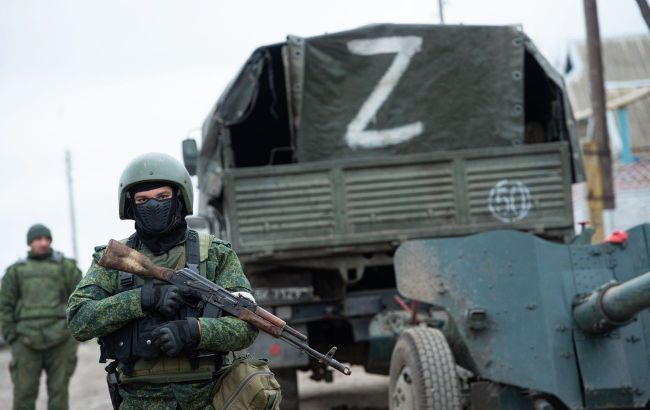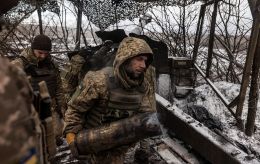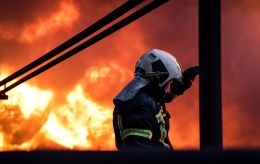ISW reports on change in Russian tactics in Kherson region after aircraft loss
 Russian occupiers alter tactics in the Kherson region due to the risk of losing new aircraft (photo: Getty Images)
Russian occupiers alter tactics in the Kherson region due to the risk of losing new aircraft (photo: Getty Images)
After the downing of several Russian fighter jets by the Ukrainian Defense Forces earlier this week, Russian invaders have slowed down their operations on the eastern shore of the Kherson region. To avoid the risk of aviation attacks, the aggressors seem to have decided to move long-range artillery closer to the Dnipro River, according to the ISW report.
Experts point to a reduction in the activity of Russian aviation after Ukrainian forces claimed to have shot down one Su-34 aircraft on the Mariupol front and one Su-30SM over the Black Sea on December 24 and 25. In addition to these, three Su-34s were destroyed by the Ukrainian Armed Forces in southern Ukraine from December 21 to 22.
On December 26, the Head of the United Coordinating Press Center of Security and Defense Forces of the South of Ukraine, Natalia Humeniuk, stated that on the eastern shore of the Kherson region, the adversary is conducting half as many ground attacks on our positions daily compared to the previous average of 30 assaults per day.
She also reported that the destruction of several Russian aircraft has weakened the enemy's ability to conduct planned bombing raids. Furthermore, the occupiers have deployed large-caliber artillery and multiple launch rocket systems (MLRS) on the left bank of the Kherson region to compensate for the lack of air support.
Colonel Yurii Ihnat, the Spokesperson of the Air Forces Command of the Armed Forces of Ukraine, announced on December 25 that Russian forces had ceased active combat operations on the Kherson front after Ukrainian forces shot down three Russian Su-34 aircraft in the south of the country.
On December 25, a Russian war correspondent claimed that Russian aviation in the Kherson region has not been operating for the past three days due to the destruction of Russian Su-34 aircraft.
According to Ukrainian military observer Kostyantyn Mashovets on December 26, Russian military forces were unable to restore the number of Su-34/34M aircraft to pre-full-scale invasion levels. Now, they must supplement the combat actions of Su-34/34M aircraft with older Su-24 aircraft. The expert mentioned that the enemy rarely deploys Su-34/34M aircraft at its bases in the occupied Crimea, likely attempting to keep them out of the range of Ukrainian strikes.
Previously, analysts from the Institute for the Study of War assessed that Russian forces may have recently increased the use of precision-guided bombs against Ukrainian forces on the right bank of the Kherson region, partially due to the successful suppression of the occupiers' long-range artillery by Ukrainian fighters.
"However, Russian forces may currently consider it better to move long-range artillery closer to the river Dnieper's coastline than risk the destruction of a larger number of aircraft," the report states.
According to ISW experts, the potential deployment of Russian long-range artillery closer to the front line could provide the Ukrainian Armed Forces with an opportunity to more easily target these types of weapons and operate more freely and safely along the Dnieper coastline and in rear areas on the western bank of the Kherson region.
Key findings:
-
The possible capture of Maryinka by Russian forces is a limited tactical gain for Russia and does not signify any operationally significant progress unless the occupiers can significantly improve their ability to conduct rapid mechanized advances, which they currently do not demonstrate.
-
However, localized Russian offensive operations continue to exert pressure on Ukrainian forces in many places along the front line in eastern Ukraine and may lead to gradual tactical advances by the interveners.
-
On December 26, Ukrainian Forces successfully launched a missile strike that destroyed a ship of the Russian Black Sea Fleet and potentially damaged the infrastructure of the port in the occupied city of Feodosia in Crimea.
-
On December 26, Russian forces targeted the railway station in the city of Kherson, where civilians were waiting for evacuation.
-
The Ukrainian government continues its efforts to systematize and enhance the resilience of mobilization in the long term.
-
Russian dictator Vladimir Putin continued to portray himself as a kind Supreme Commander of the Armed Forces of the Russian Federation, while simultaneously highlighting his apparent dissatisfaction with the irregular forces and the incompetence of the Russian Ministry of Defense.
-
25 and 26 December saw a series of meetings in St. Petersburg among the member countries of the Eurasian Economic Union (EAEU) and the Commonwealth of Independent States (CIS).
-
Russian actors seized on the ongoing protests in Serbia against President Aleksandar Vucic to blame Western actors for causing instability in Serbia, which Russia perceives as a long-term European ally.
-
A well-known Russian war correspondent associated with the Kremlin claimed that Finland is becoming the second Ukraine, drawing rhetorical parallels between Russian narratives about Ukraine and Finland, suggesting that Russia maintains future ideological and territorial goals that far exceed the war against Ukraine.
-
Russian forces confirmed advances in the areas of Kupiansk, Avdiivka, Mariinka, and Robotyne, as positional combat operations continued along the entire front line.
-
Russian dictator Vladimir Putin signed a series of laws on December 25 aimed at further strengthening the potential of the Russian armed forces.
-
The Kremlin continues to formalize ways to compel residents of the occupied part of Ukraine to obtain Russian passports through the disbursement of maternal capital.
Destruction of Russian aircraft
On December 22, Ukrainian Forces managed to destroy three Russian Su-34 fighter-bombers in the Kherson region within a day.
By December 24, the Ukrainian air defense system had eliminated another Su-34 and one Su-30 belonging to the Russian occupiers.
As stated by the Center for Strategic Communications and Information Security, the Ukrainian Air Defense Forces exceeded their success in eliminating enemy aviation in the Bryansk region.

